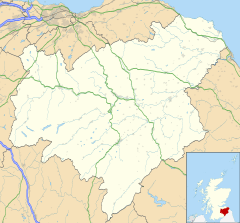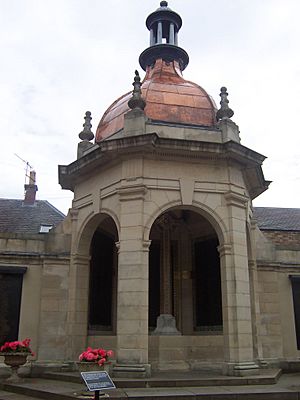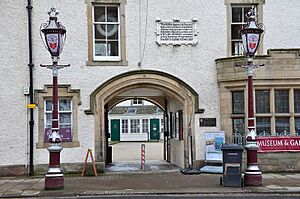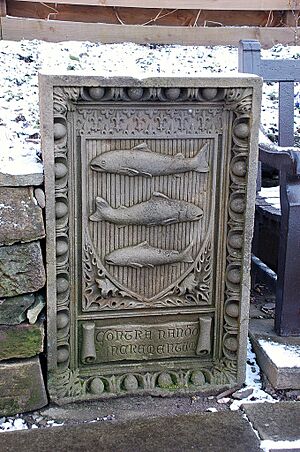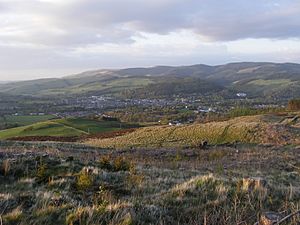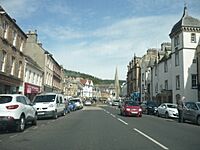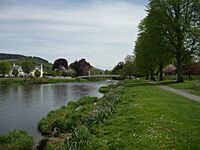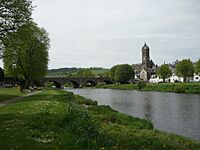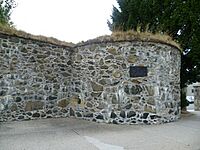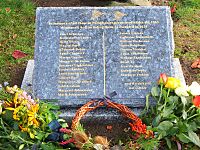Peebles facts for kids
Quick facts for kids Peebles
|
|
|---|---|
An aerial view of Peebles |
|
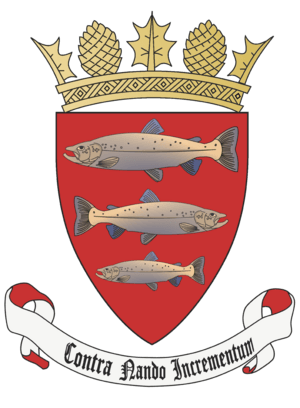 Peebles' Coat of Arms |
|
| Area | 3.85 km2 (1.49 sq mi) |
| Population | 9,000 (2020) |
| • Density | 2,338/km2 (6,060/sq mi) |
| OS grid reference | NT2540 |
| • Edinburgh | 21 mi (34 km) |
| • London | 313 mi (504 km) |
| Council area | |
| Lieutenancy area | |
| Country | Scotland |
| Sovereign state | United Kingdom |
| Post town | PEEBLES |
| Postcode district | EH45 |
| Dialling code | 01721 |
| Police | Lothian and Borders |
| Fire | Lothian and Borders |
| Ambulance | Scottish |
| EU Parliament | Scotland |
| UK Parliament |
|
| Scottish Parliament |
|
Peebles (Scottish Gaelic: Na Pùballan) is a lovely town in the Scottish Borders, Scotland. It used to be a very important royal burgh and the main town of Peeblesshire. In 2011, about 8,376 people lived here. By June 2018, the number grew to around 9,000.
Contents
History of Peebles
Peebles started as a market town. In the 1800s and early 1900s, it was important for making woollen goods. Most of the wool factories closed by the 1960s. The last one stayed open until 2015.
Today, Peebles is a popular place for people who work in Edinburgh. It is also a great spot for tourists, especially in summer. In the past, people came here for health holidays. They stayed in special hotels called hydropathic establishments. The Peebles Hydro Hotel is one of the few still open from that time.
Important buildings in Peebles include the Old Parish Church of Peebles and Neidpath Castle. You can also visit a local museum and the Kailzie Gardens. Peebles has won many awards for its shops on the High Street.
Old Buildings and Traditions
The oldest building in Peebles is the tower of St Andrew's Church. This church was built in 1195. It was later destroyed by soldiers, leaving only the tower. Its stones were used to build other local places. Another old church is the Cross Kirk, started in 1261. Even though it's mostly ruins now, it's a big part of the town's festival.
The yearly festival in Peebles is called the Beltane. It includes a "Common Riding," which is a parade on horseback. The Beltane ends with the crowning of the Beltane Queen. She is a girl chosen from one of the three local primary schools. She has a court with other children. The main adult in the festival is the Cornet. This young man carries the town's flag for a year.
West of town is Neidpath Castle. You can walk to it through Hay Lodge Park and enjoy views of the castle. The castle is not open to visitors anymore.
On the High Street, you'll find the old town offices. This building is called the Chambers Institution. It holds the town's library, art gallery, and museum. William Chambers, a famous publisher, gave the building to the town. His family came from Peebles.
Peebles used to have a railway. It connected the town to Edinburgh and Galashiels. Now, buses like the Borders Buses service X62 connect Peebles to Edinburgh.
Peebles' Coat of Arms
The official symbol of Peebles is its coat of arms. It shows three salmon on a red background. The fish are swimming in a special way. One salmon faces forward, and two face backward. This shows that for every salmon that swims up the River Tweed to lay eggs, two come back to the sea.
The town's motto is Contra Nando Incrementum. This is Latin for "There is growth by swimming against the stream." It refers to the salmon swimming upstream.
This coat of arms is very old. It first appeared before 1320 on the town's market cross. The colors were not always the same, but red was chosen as the official background in 1894.
After the old towns in Scotland changed in 1975, the coat of arms was given to the Royal Burgh of Peebles and District Community Council in 1988. They still use it today.
Where is Peebles?
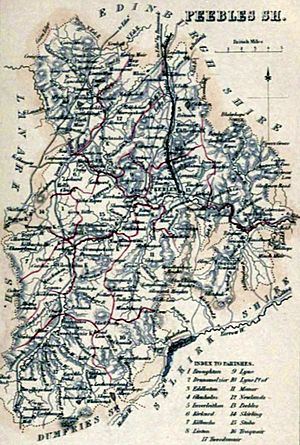
Peebles is located where two rivers meet: the River Tweed and Eddleston Water. The Tweed flows from west to east. The Eddleston Water flows from the north. It turns southwest before joining the Tweed. This creates a triangle of land where the town sits.
The name "Peebles" likely comes from an old language word pebyll, meaning "tents." This suggests it was once a temporary camp.
Around 1570, the east side of Peebles had a town wall. The road to Glentress went through a gate in this wall called the East Gate. There were four main gates in Peebles: Eastgate, Northgate, Bridgegate, and Ludgate (now Young Street).
Today, an old market cross stands where Eastgate and Northgate roads meet. The main street, Peebles High Street, runs next to the River Tweed.
Things to Do in Peebles
In 2014, Creative Scotland said Peebles was the most creative town of its size in Scotland. The town received an award and money to help with arts events and festivals. Most art shows happen at the Eastgate Theatre on the High Street. It has music, plays, dance, and classes all year.
Peebles also has four big yearly festivals: the Beltane Festival, Peebles Arts Festival, Tweedlove Bike Festival, and Imaginarium.
Peebles is a great place for people who love walking, cycling, and horse riding. The John Buchan Way is a 22-kilometer (14-mile) walking path that starts here. The Cross Borders Drove Road, an 82-kilometer (51-mile) route, also goes through the town.
The town has two old sports clubs. Peebles Rovers F.C. is the senior football team. Peebles RFC is the rugby team. Peebles also has an 18-hole golf course.
Peebles has three primary schools: Kingsland, Priorsford, and Halyrude Primary School. It also has the biggest secondary school in the Borders, Peebles High School. Students from all over the area go there.
In 2005, a study found that Peebles was the best town in Scotland for its independent shops and "home town identity." It was the second best in the UK.
The local hospital is Hay Lodge Hospital.
Notable people
Many interesting people have connections to Peebles:
- David Ballantyne (1914–1997), a cricketer.
- John Bathgate (1809–1886), a New Zealand politician who grew up here.
- Eric Bogle (b. 1944), a folk musician born in Peebles.
- Scott Brash (b. 1985), an Olympic gold medallist.
- John Buchan (1875–1940), a famous author and politician.
- Robert Chambers (1802–1871), a publisher and author.
- William Chambers (1800–1883), a publisher and Robert's brother.
- Finlay Christie, a New Zealand rugby player born in Peebles.
- Brian Cook (football administrator) (b. 1955), an Australian football leader born in Peebles.
- Bill Gilmour (b. 1939), a film and TV producer/director.
- James Grieve (1841–1924), a plant expert who gave his name to the James Grieve apple.
- Sir Robert J. M. Inglis (1881–1962), a railway engineer.
- O. Douglas (Anna Masterton Buchan) (1877–1948), a novelist. Her novels often feature a town like Peebles.
- William Keddie (1809–1877), a scientist and creator of the Scottish Sunday School system.
- Charles Leedham-Green, a mathematician known for his work on group theory.
- John Mathison (1901–1982), a New Zealand politician born in Peebles.
- Ernest Maylard (1855–1947), a surgeon and mountaineer who retired and is buried here.
- B. N. H. Orphoot (1880–1964), an architect.
- Mungo Park (1771–1806), an explorer who worked as a doctor in Peebles.
- Alexander William Stewart (1868–1933), a naval architect and inventor.
- Catherine Maxwell Stuart, 21st Lady of Traquair (born 1964), born in Peebles.
- Kevin Thomson (b. 1984), a footballer who grew up in Peebles.
- Marioun Twedy (fl. 1649), accused of witchcraft in Peebles.
- John Veitch (1829–1894), a philosopher and poet born in Peebles.
Twin town

 Hendaye, Basque Country, Pyrénées-Atlantiques, France
Hendaye, Basque Country, Pyrénées-Atlantiques, France
Gallery
-
Remains of the town wall corner bastion.
See also
 In Spanish: Peebles (Scottish Borders) para niños
In Spanish: Peebles (Scottish Borders) para niños


